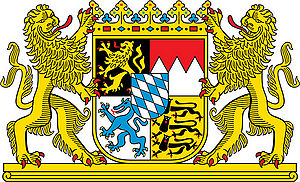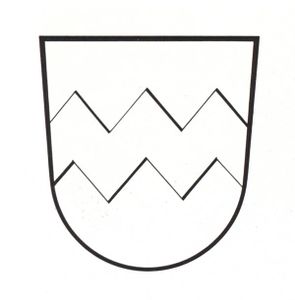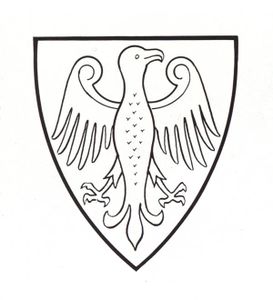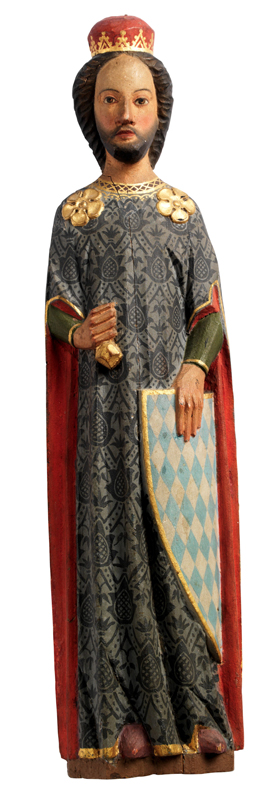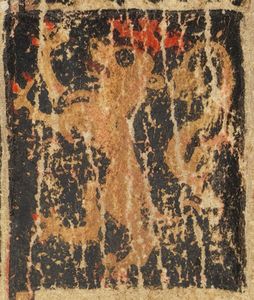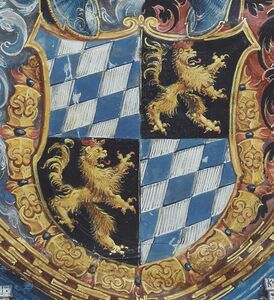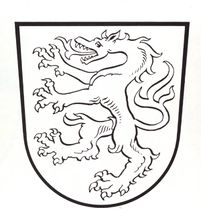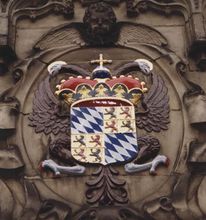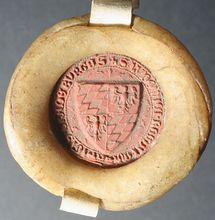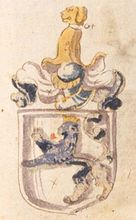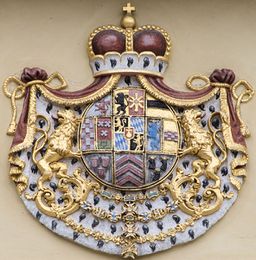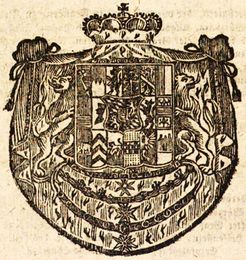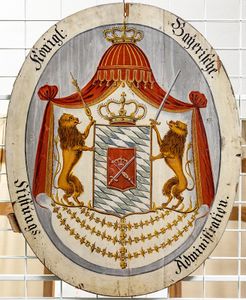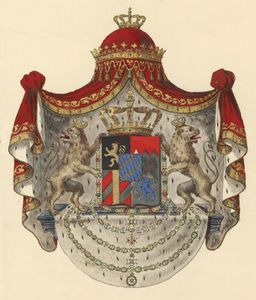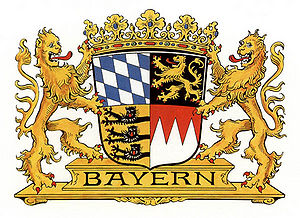EN:Bavarian coat of arms
Aus Historisches Lexikon Bayerns
Coats of arms have been used as identification on the empty area of shields worn on the arm, which were part of a knight's armour, since the 12th century. The earliest coat of arms of the Wittelsbach dukes show a bar broken up several times (zigzag) or a heraldically stylized eagle. The characteristic coat of arms of the House of Wittelsbach can be traced from the first half of the 13th century: the lion from the Rhenish counts palatine's heraldry and the lozenges argent-azure originally used by the counts of Bogen. The "panther", which was adopted by the counts of Ortenburg-Kraiburg and symbolised Lower Bavaria, was already added at the end of the 13th century. The three silver points in gules ("Franconian rake") representing Franconia were added in the 19th century and the three lions from the coat of arms of the Staufer representing Swabia in 1923. Eduard Ege created the coat of arms of today's Bavaria in the style of the royal coat of arms of 1835.
Genesis
Coats of arms have existed since the 12th century. The armament of the knights who formed the core of the army columns in the high Middle Ages changed at that time. The armour encased the whole of the horseman's body, the bucket helmet covered the fighter's head and neck with the visor down, so that his individual physiognomy was no longer recognisable. The knight carried a shield on his arm. Its empty area offered space for charges or geometric figures to identify the shield carrier. This situation resulted in the basic features of each coat of arms, which are still in use today: it must be in a shield-shaped frame and defined according to shape, figure and colours.
Originally, coats of arms were to identify the knight or his retinue's horseman. They soon passed from father to son and with their hereditability were an important element for the formation of dynasties in the social class of the leading medieval nobility. The use of coats of arms also spread to the church because the higher clerics came from the aristocracy and the secular dominions of the bishops (high monasteries) had to provide (military) contingents identified by their own coats of arms. Coats of arms were also used by towns, which grew significantly in numbers and importance since the High Middle Ages, as signs of property, rule and borders.
The Duke's coats of arms in Bavaria
Since Otto von Scheyern-Wittelsbach (ruled 1180-1183) had been enfeoffed by Emperor Friedrich I Barbarossa (ruled 1152-1190) with the dukedom of Bavaria in 1180, the family remained in possession of the highest secular office in the country until 1918. It had considerable property and dominion and was related by blood and marriage to the great dynasties. A skilful acquisition policy and the forceful pursuit of inheritance claims meant that the power, possessions and influence of the House of Wittelsbach could be increased in Bavaria and far beyond into the Franconian and Rhineland regions.
The Bavarian duke's coats of arms illustrate this development. The first coats of arms documented on the dukes' equestrian seals show a simple charge: a bar running horizontally through the shield, broken up several times (so-called zigzag bar), which can be regarded as a sign of the house's patrimony of Altwittelsbach; as this picture also appears in the heraldry of the House of Wittelsbach's Scheyern, Indersdorf and Ensdorf monasteries. The dukes' ministerials also had this coat of arms.
In addition, for the first three dukes from the House of Wittelsbach there is evidence of coats of arms with the heraldically stylized eagle charge. The eagle was the symbol of the Emperor and the Empire; therefore many officials and aristocratic families dependent on the Emperor and the Empire also had this charge, the early House of Wittelsbach perhaps also in their position as Bavarian Counts Palatine.
However, they discarded this charge before the middle of the 13th century, as well as the symbol of the house's patrimony, the heraldic zigzag bar. Two new charges were now introduced to Bavarian heraldry.
The lion and lozenges
A coat of arms featuring a lion was depicted for the first time on a Bavarian duke's seal in 1229. It belonged to Duke Otto II (ruled 1231-1253); he had married Agnes of the Palatinate (died 1267), the heiress to Heinrich (ruled 1195-1212), the last of the Palatine line of the House of Welf, and had entered into office and possession of the Counts Palatine of the Rhine after the death of his father-in-law (1227). The adoption of the lion charge from the heraldry of the Rhenish Counts Palatine signals the House of Scheyern-Wittelsbach-Bavaria´s turn towards the Rhine-Mosel-Franconian area and to that large aristocratic society of the Middle and Lower Rhine whose members had a lion in their coats of arms. The coats of arms only differed in detail by the colour and smaller additions. The heraldic lion, a lion or with crown gules in a field sable, became a symbol for the entire House of Wittelsbach in the 13th century. Bavarian dukes, who had no state share in the County Palatine of the Rhine, also made use of it, as they also held the title of Count Palatine. The Palatine lion was and still is the most important heraldic symbol for the whole of Bavaria besides the lozenges argent-azure.
The coat of arms featuring the lozenges was also adopted by the dukes of Bavaria in the first half of the 13th century, when they inherited a large property and dominion complex from the Counts of Bogen (1242). Like the "Palatine" lion, the "Bavarian" lozenges were only introduced by the Scheyern-Wittelsbachs in secondary use. This is an indication of the close and strong bond that existed between a large family patrimony and the external symbol of the coat of arms as its feature. The colours of the coats of arms (lion or with crown gules in field sable and lozengy shield divided by argent and azure) are occasionally documented in the 13th century, more frequently in the 14th century. The order of the colours argent and azure is defined by the lozenge cut in the (heraldically) right (top) corner of the shield; this should be argent. The order of the illustrated colours on the lozenge shield changed until well into the 16th century; azure was also shown first. Then the "Weiß-Blau" (argent-azure) series of Bavarian lozenges, which is still valid today, became established.
"Weiß-Blau" (argent-azure) are also the colours of the Bavarian flag according to the traditional principle that the colours of the coat of arms determine the colours of the owners´ flag. This is also stated in the Bavarian Constitution of 1946 (Article l, paragraph 2). The colours of the lion charge in the coat of arms have never played a role in determining the national colours.
The two coats of arms of the House of Wittelsbach that were kept in separate shields by the dukes in the 13th and 14th centuries, were combined into one shield from the middle of the 14th century onwards. This was most frequently done in the form of the quartered coat of arms where the shield is divided into four fields by a vertical and a horizontal line in which the charges are repeated diagonally opposite each other. Often in coats of arms of the Palatine House of Wittelsbach the lion is in first and fourth place, and in coats of arms of the dukes of the Bavarian lines the lozenges argent-azure are in this position.
The two heraldic figures first are symbols for the family of the "House" of Bavaria and then also for the "country". The lozenges in particular are often referred to as the "Wappen Baierlands" (coat of arms of the land of Bavaria). This symbolism, which goes far beyond the dynastic, is also particularly visible in the fact that in the coats of arms of many cities and market towns as well as in official and court seals of Bavarian municipalities and authorities the affiliation to the Royal House and to the country is represented by the symbols originating from the family heraldry.
The lion shield was originally the coat of arms of the Counts Palatine of the Rhine. It was used by the House of Wittelsbach from 1214. Oldest known coloured depiction from Zürich armorial c.1330-1345. (Public domain via Zürich, Schweizerisches Nationalmuseum, AG 2760, f. 1v – Zürcher Wappenrolle)
Quartered coat of arms, evidenced on the seals of the Counts Palatine of the Rhine since the 1340s and on those of the Dukes of Bavaria since the end of the 14th century. (Bayerische Staatsbibliothek - Bavarian State Library, Mus.ms. A II(1)
Acquisitions of other coats of arms
In the later 13th century, the Duke of Lower Bavaria Heinrich XIII (ruled 1253/55-1290) succeeded in significantly extending his dominion in the Rottal, in the Salzach-Inn region and in the Chiemgau at the expense of the counts of Ortenburg-Kraiburg. This was also represented heraldically. The previous owner's coat of arms was the so-called panther - a mythical creature with a horse's trunk and a long neck with a fire-breathing dragon's head. The Bavarian duke adopted this, assigned it to his highest official, the viscount, as an official symbol and had it included in the coats of arms of Bavarian cities. Ludwig der Bayer (ruled 1294-1347 as Duke of Bavaria and Upper Bavaria, as Roman-German King from 1314, as Emperor from 1328) and his son Ludwig VI der Römer (ruled 1347-1365 as Duke of Upper Bavaria, 1351-1365 as Margrave of Brandenburg) also used this special Lower Bavarian symbol. This image regained relevance for the Bavarian state heraldry when the designer of the state coat of arms of 1950, Eduard Ege, chose this heraldic charge as a symbol for Lower Bavaria.
New lion charges appear in Bavaria's heraldry several times: for example, when Lodwig der Bayer married Margarete of Hainaut-Holland (1311-1356), who then inherited the Dutch counties that carried the so-called Four Lions coat of arms. Their descendants had the lion charge in their coat of arms as dukes of Bavaria-Straubing-Holland until the early 15th century.
The eagle charge in Bavaria's heraldic tradition goes back to the time of Ludwig der Bayer. He had transferred the Margraviate of Brandenburg (1323) and the County of Tyrol (1342) to his son Ludwig der Brandenburger (ruled 1347-1361 as Duke of Upper Bavaria, 1323-1361 as Margrave of Brandenburg). Both dominions had the eagle gules in the shield argent, which was combined with Bavarian lozenges and lion coats of arms. This connection did not last long. Tyrol was lost to the House of Habsburg in 1369, Brandenburg to Karl IV (ruled 1346-1378) in 1373.
Coat of arms of Duke Albrecht I of Straubing-Holland (ruled 1347-1404) at the Hoogheemraadschap van Delfland in Delft (Netherlands). (Photo: Stadtarchiv Straubing - Straubing Municipal Archive, Allgemeine Fotosammlung)
Coat of arms with lozenges and eagles, used in the 14th century by the Wittelsbach Electors of Brandenburg. Seal of margrave Ludwig VI dem Römer used on a deed from Monastery Pettendorf of 13 December 1355. (Staatsarchiv Augsburg - State Archive Augsburg, Reichsstift Kaisheim - Kloster Pettendorf Urkunden 96)
Coat of arms of the Counts of Veldenz with the lion azure, c. 1600. (Bayerische Staatsbibliothek - Bavarian State Library, Cod.icon. 307)
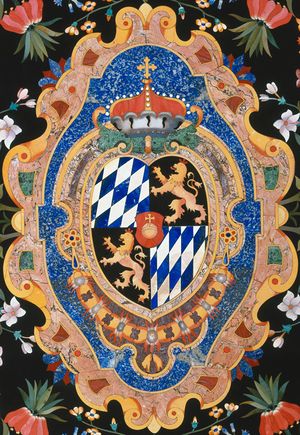
A lion charge, which played a role in Bavaria's dynasty and state heraldry for a long time, was the lion azure in the field argent of the Counts of Veldenz, whose patrimony in the Mosel-Nahe area had passed to the Wittelsbach Counts Palatine of Zweibrücken in the 15th century. The Veldenz lion appears in the coats of arms of various Wittelsbach lines. In 1835, King Ludwig I (ruled 1825-1848) finally adopted the coat of arms of Bavaria, which he had redesigned in remembrance of the fact that his family belonged to the Palatine Zweibrücken line.
The position of elector held by the House of Palatine-Bavaria was also depicted in the coat of arms. Initially, the Heidelberg Counts Palatine were holders of the Arch-Stewardship of the Holy Roman Empire and consequently members of the Electoral College. They therefore had a particular shield gules in their coat of arms, which contained the imperial orb or from the middle of the 16th century. In 1623, this coat of arms passed to Maximilian of Bavaria (ruled 1597-1651, as Elector from 1623), who received the first Position of the first among the secular electors from the Emperor, which had been denied to his cousin Friedrich V of Palatine (ruled 1610-1623) under the ban of the Empire. The Arch-Steward shield with the imperial orb was an integral part of the Bavarian Elector's coat of arms until the end of the Empire in 1806.
Bavaria's state coat of arms in the 19th and 20th centuries
Large coat of arms of the Electorate of Bavaria of 1804. Figure from Regierungsblatt für die Churpfalzbaierischen Fürstenthümer in Franken from 1804, 232. (Bayerische Staatsbibliothek - Bavarian State Library, 4 Bavar. 3059 d-2)
The Electoral coat of arms of Palatinate-Bavaria, which Elector Max IV Joseph (ruled 1799-1825, as Bavarian king from 1806) had redesigned for the last time in 1804, contained a total of 19 symbols for dominions of old property and new acquisitions (including those after the Imperial Recess of 1803). This historically highly differentiated and expressive variety was eliminated by the newly created royal coat of arms on the occasion of the royal proclamation of 1 January 1806. The shield was divided into 42 lozenges argent and azure, which symbolically represented the parts of the country united in the kingdom. An inescutcheon with symbols of power (crown, sword and sceptre; at the beginning also with the Palatine imperial orb and crowned lion charge) was placed on the lozengy shield. The rationalism of the Montgelas epoch thoroughly cleared up the historical detailed explanation in the king's and state heraldry; the traditional dominion names in Old Bavaria and in the acquisition areas disappeared and were replaced by the district names derived uniformly from the river names. The break with the historically founded symbolism of the state and the names of the parts of the country reflecting the former structures of power was extensive and seemed final.
But just 30 years later, the ideological reversal in the question of the coat of arms and in the names of the parts of the country was on the agenda. In 1835 King Ludwig I redesigned the royal coat of arms, which was to be understood as the state coat of arms, to express his historical understanding, which was influenced by Romanticism, and to represent the kingdom's "tribal structure". According to the simultaneously revised title, the king was "Count Palatine of the Rhine, Duke of Bavaria, Franconia and Swabia". The new coat of arms was therefore divided into four fields. In the first quarter was the Palatine lion, in the second quarter the charge for Franconia (per fess indented argent and gules from the episcopal Würzburg heraldry), in the third quarter the Swabian badge (bendy sinister argent and gules, a pale or from the coat of arms of the Margraviate of Burgau in Swabia) and in the fourth quarter the lion azure of the Counts of Veldenz as an indication of the origin of the dynasty from the Rhine Palatinate. The lozenges for the whole of Bavaria were in the inescutcheon.
This coat of arms, carried by the king and the higher authorities and courts, was widespread and generally recognised. There was also a small state coat of arms consisting of the lozenge shield used by the external offices. This was the case until 1918.
In the autumn of 1918, the revolutionary government under Kurt Eisner (1867-1919) commissioned the heraldist Otto Hupp (1859-1949), who had lived in the Munich art scene for decades, to design a symbol for the Free State of Bavaria. It was never in doubt that Hupp would base his proposal on Bavaria's traditional heraldic images. In a formally excellent drawing, fully in keeping with the Bavarian heraldic tradition, Hupp combined the badges of Old Bavaria (lozenges), Palatine (lion), Swabia (three lions from the Staufer coat of arms) and Franconia (three points) in a quartered coat of arms. On the shield he affixed a royal foliage crown designed based on the late medieval model, which he made palatable to the democratic Landtag making the decision on the state coat of arms as a "people's crown" and thus as a symbol of the people's sovereignty. In 1923, the Parliament passed the law on the republican coat of arms. The Bavarian coat of arms of 1923 disappeared with the unification of the states by the National Socialist "Third Reich" in 1933.
In 1945/46 Bavaria was re-established as a separate state at the instigation and with the help of the US military government. In late autumn 1945, Minister President Wilhelm Hoegner (1887-1980) commissioned the Munich graphic artist Eduard Ege to design a new coat of arms for the Free State of Bavaria. Together with the Bavarian State Chancellery, Ege designed the state symbol based on the model of Ludwig I's royal coat of arms: four fields filled with the lozenge shield, which was conceived as an overall Bavarian symbol of integration. Symbols for the regions in the fields: Old Bavaria (lion or on sable), Franconia (per fess indented argent on gules), Old Bavaria, specifically Lower Bavaria (panther azure on argent), Swabia (three lions sable on or). On the shield, which is held by two lions or, rests the "people's crown" as a sign of the people's sovereignty. In 1950 the Bavarian Landtag decided on the state coat of arms based on this description. The traditional symbols of Bavaria's history have therefore been summarized once again.
References
- Klemens Stadler (Bearb.), Wappen in Bayern. Ausstellung des Bayerischen Hauptstaatsarchivs München in Verbindung mit der Bayerischen Staatsbibliothek aus Anlaß des 12. Internationalen Kongresses für genealogische und heraldische Wissenschaften, München, 6. September-27. Oktober 1974 (Ausstellungskataloge der Staatlichen Archive Bayerns 8), Neustadt a. d. Aisch 1974, 122-140.
- Wilhelm Volkert, Die Bilder in den Wappen der Wittelsbacher, in: Hubert Glaser (Hg.), Die Zeit der frühen Herzöge. Von Otto I. zu Ludwig dem Bayern. Beiträge zur Bayerischen Geschichte und Kunst 1180-1350 (Wittelsbach und Bayern I/1), München 1980, 13-28.
Further research
External links
Cite
Wilhelm Volkert, Bavarian coat of arms, published 22 May 2012, english version published 9 March 2020; in: Historisches Lexikon Bayerns, URL: <http://www.historisches-lexikon-bayerns.de/Lexikon/EN:Bavarian_coats_of_arms>(23.04.2024)

